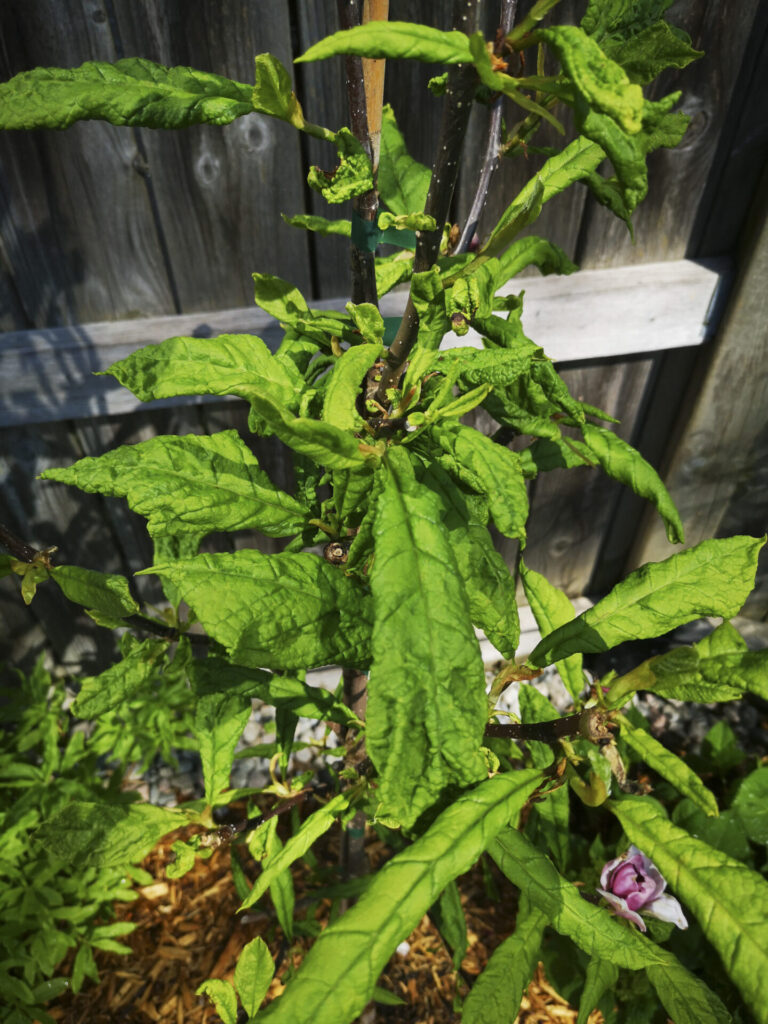
We live around Birch Cliff in Toronto and planted this Genie Magnolia at the end of April.
Unfortunately all leaves and flowers are coming curly.
We are watering it every day, it is planted in sunny spot in sandy soil.
Also we have one northern lights Azalea close to the tree which was planted at the same time.
Azaleas leaves are also curling( last two weeks before it looked perfectly fine) with some small brown spots.
Is it treatable?
Thanks for the help
Thank you for contacting the Toronto Master Gardeners.
Magnolia ‘Genie’ is a hybrid with an upright pyramidal structure that ĺproduces tulip-shaped, reddish-purple flowers that emerge before foliage in spring. Genie is hardy to Zone 5 so it should be suitable to your location. However, it should be sheltered from winds that can damage the delicate flowers and branches, so a windbreak would be a good idea. Genie prefers moist, but well-drained soil that is neutral to acidic. It will tolerate partial shade, but flowering may be reduced.
There are several factors which could cause the leaf curl that you are seeing in your magnolia tree. Often with environmental issues leaves come out green and healthy then slowly turn discolored. If yours are starting off green but curled, would check to see if there is some sort of sucking insect pest inside the curled edge of the leaf or on the lower surface of the leaf.
There are several pests such as scales, aphids, thrips and caterpillars which can attack the magnolia causing various degrees of damage, but they generally won’t threaten the magnolia’s life. Scales, aphids and thrips feed on the cell content of plants causing wilted and discolored leaves that may die and fall off the tree prematurely. A sure sign of aphids and scale is if you notice a sticky appearance on your leaves.
Rolled leaves can also be a symptom of watering problems–too much or too little–or some nutrient deficiencies. Even with your diligent watering, a number of other factors can still lead to the new tree’s roots not being able to take up enough water.
The way a tree is planted has a huge impact on the future health and proper establishment of the tree. We encourage you to go through our Planting a Tree: A Toronto Master Gardeners Guide to see if best practices were followed when it was planted. In particular:
- Was the container/burlap/wire basket etc. completely removed prior to planting?
- Were the tree roots checked for health and presence of girdling roots? Any roots found girdling the root system must be removed, otherwise such roots will continue to grow in circles and eventually strangle the tree
- Was the planting hole wide enough?
- Was it planted at the correct depth? A tree should not be planted too deep—you should be able to see the trunk flare above ground
- Was sufficient mulch (2-3 inches deep) placed around the tree (but not touching the trunk) to help conserve moisture and regulate soil temperature?
Sand-based soils drain well, but may dry out quickly if organic matter is lacking. You can improve sandy soils before planting a magnolia by adding acid-forming organic matter–such as compost of oak leaves, coffee grounds, and the bark and needles of conifers. Sandy soils do not compact easily, but can warm and cool quickly to the detriment of a plant. A thick layer of mulch, 4 to 5 inches in depth, atop the root system of a magnolia will aid in moderating soil temperatures–particularly in the summer heat. The mulch also retains soil moisture. In general, magnolias planted in sandy soils should not be exposed to drying winds and full sun exposures.
You might like to call a certified arborist. He would be able to assess the tree and offer proper advice on what steps may need to be taken in caring for it. The best way to find a certified arborist is to access the International Society of Arborists through their web-siteisaontario.com . The following is a link to arborists in Toronto: www.isa-arbor.com/findanarborist/findanarborist.aspx.
Good Luck with your magnolia.

